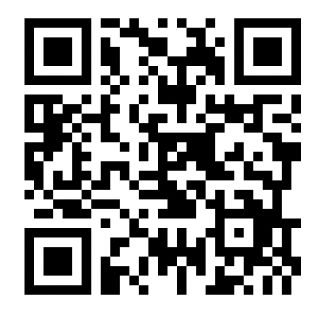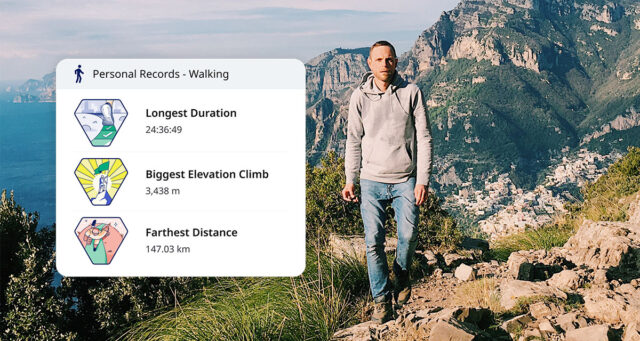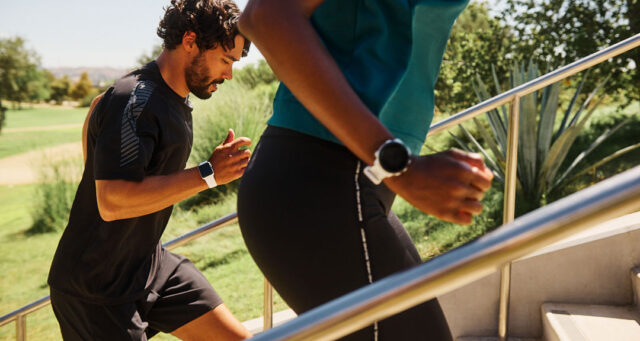Running is simple, but not quite as simple as going out and running at the same effort every single day. In order to get faster and prevent injury, you want to vary the effort of your runs. Some runs will be a low-intensity, others a moderate/moderately-hard intensity, and a few at a high intensity. But how do you determine the intensity of a run?
Heart rate training, rate of perceived exertion, and pace are all common methods to measure your effort on a run. Each has its advantages and disadvantages. The one that works best? The one that you find most helpful for your specific training!
Using heart rate to gauge effort
Heart rate training is popular for a good reason: if you have the right technology, it provides an objective way to gauge your effort on a run. You use a device (ideally a chest strap) to record the number of beats per minute your heart is making. The more beats per minute, the harder you are working. To gauge your effort on a run, you determine your maximum heart rate and your corresponding heart rate within training zones.
It is essential to note that you will need to use a chest strap if you want accuracy. Multiple research studies determined the inaccuracy of wrist-based heart rate monitors. For example, a study in Medicine and Science in Sport and Exercise found that wrist-based monitors were often 20 bpm (or more) off of an ECG reading. Chest straps, on the other hand, are highly accurate when used properly. (The Bluetooth on your phone can connect the ASICS Runkeeper app to a heart rate monitor for accurate data.)
Tests for heart rate training
Not sure how to determine your heart rate? Age-based formulas are generally reliable for a majority of the population, but they may not be the more accurate for you. If you want precision with heart rate training, you will want to test your own heart rate.
One test, pioneered by Joel Friel, determines your heart rate at your lactate threshold. The test is a simple solo 30-minute time trial. You run as hard as you can for 30 minutes (ideally on flat, uninterrupted terrain such as a track) while wearing a heart rate monitor. Your average heart rate in the final 20 minutes of the time trial is your lactate threshold heart rate (LTHR).
From there, you can calculate your heart rate for training:
- Zone 1 (recovery runs) (<85% LTHR)
- Zone 2 (easy runs, most of your training) (85-89% LTHR)
- Zone 3 (moderate effort) (90-94% LTHR)
- Zone 4 (tempo runs) (95-99% LTHR)
- Zone 5 (interval runs) (100-106% LTHR)
An alternative test comes from Jack Daniels’ Running Formula. The renowned coach and physiologist recommends a test of repeated 2-minute uphill runs. After an ample warm-up, you run as hard as you can up a hill for 2 minutes and record your heart rate. You walk back down and recover, then repeat the 2-minute uphill run. Once your heart rate is not higher than the previous rep (this may take three to four reps), then you know you have reached your max heart rate. (If there are no hills in your area, you can do a series of 800-m repeats instead).
If you are using the Daniels Formula method or a standard age-based formula, you can then calculate your heart rate zones:
- Easy runs: 65-75% of MHR
- Tempo runs: 87-92%
- Intervals: 95-100% of MHR
Each of these methods of gauging effort on a run has pros and cons. If you want to use heart rate training, you should know the advantages and disadvantages of it, as these will help you use it most effectively.
Pros of heart rate training:
- Heart rate accounts for the impact of environmental factors on your pace
- It is easy to determine your training zones and to use it as a beginner
- Heart rate provides objective data
Cons of heart rate training:
- External factors such as caffeine consumption or stress can elevate your heart rate
- Wrist-based watches are not accurate, especially during activity; you will need to use a chest strap for accurate measurement
- Heart rate is not practical for racing
Determining effort with rate of perceived exertion (RPE)
Do you ever wonder how people trained before GPS watches and apps? They ran based on perceived effort. This method has a learning curve as you learn to accurately assess your effort, but it can be highly beneficial. You do not need to rely on technology, which means you can stay on pace even if your battery dies or you lose signal.
There are several scales for RPE, but the simplest to use is the talk test. The harder you are working, the more labored your breathing will be.
- Recovery runs/easy runs: able to carry on a conversation
- Threshold/tempo runs: able to speak only a short (5-7 word) sentence
- Intervals: only able to speak a word or two
An alternative to the talk test is perceived exertion based on race effort. This approach is ideal for a more seasoned runner; beginners without racing experience may not find it useful. A very basic approach to this method of perceived exertion is:
- Recovery runs/easy runs: ‘run all day’ effort
- Threshold: the pace you could maintain for an hour of racing
- VO2max (intervals shorter than 5-minutes): the pace you can sustain for a 10-15 minute race
Pros for RPE
- It directly translates to any condition: summer, winter, roads, trails, training runs, races, etc
- It is free to use and does not require technology
- You do not need a time trial or race to calculate it
Cons for RPE
- There is a learning curve to learn to assess your RPE; may not work well for beginners
- RPE is subjective; even skilled runners may under or overestimate their exertion
Gauging your effort using pace
One of the most popular metrics for gauging intensity is pace. With GPS apps and watches, it is simple to use. Over time, pace helps you see progress in your training, while the other two methods will not. While the pace may need to be adjusted for certain conditions (see below), it can be used by any level of runner, from absolute beginner to competitive marathoner.
Calculating pace is simple. You can use a recent race or a time trial to calculate. A calculator such as the VDOT pace calculator will determine your paces at different intensities based on your fitness.
Pros:
- You can use a smartphone app (such as ASICS Runkeeper™) or a GPS watch to record the pace
- You can easily update your paces based on recent races or time trials
Cons:
- Environmental conditions such as heat, humidity, and wind can all affect pace. There are conditions where you will need to adjust your pace. In those situations, it may be helpful to gauge your effort based on RPE or heart rate instead
- Pace will be different on uphills, downhills, and trails
- The pace is relative for each runner! A 9:00/mile pace may be one runner’s easy day and another runner’s sprint. It is important to determine paces based on your current fitness, not on your training partner’s fitness or your goals
No matter which method you use, you want to be consistent in its use. If you are using heart rate training, use your monitor on every run. If you are using pace, be sure to update your zones after you run a race. If you prefer perceived exertion, calibrate it on each run by assessing your breathing. With consistency, each of these methods will help you become a faster runner.
Please note: This blog is not intended to be a substitute for professional medical advice, diagnosis, or treatment. Always seek the advice of your physician or other qualified health provider with any questions you may have regarding a medical condition.






